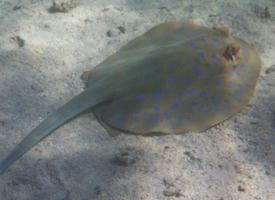
Greutăți și măsuri
| Greutate | 30 kg |
|---|
Descrierea animalului
The Bluespotted Ribbontail Ray, scientifically known as Taeniura lymma, is a strikingly beautiful and fascinating species of stingray that inhabits the tropical and subtropical waters of the Indian Ocean and the western Pacific Ocean. This species is easily recognizable by its vibrant coloration and distinctive markings, making it a favorite among divers and marine enthusiasts.Characterized by its round, pectoral disc-shaped body, the Bluespotted Ribbontail Ray typically reaches a width of about 35 centimeters, though some individuals can grow larger. The body of the ray is a deep, rich blue or blue-green color, adorned with numerous, eye-catching electric blue spots. These spots serve not only as a stunning visual feature but also play a role in camouflage, helping the ray blend in with the sandy bottoms and coral reefs where it prefers to dwell.
The "ribbontail" in its name refers to the ray's long, slender tail, which is usually about twice the length of its body. The tail features a series of black and white bands, giving it a ribbon-like appearance, and is equipped with one or two venomous spines. These spines are used for defense against predators and can deliver a painful sting to humans if the ray is threatened or accidentally stepped on.
Bluespotted Ribbontail Rays are benthic creatures, meaning they spend most of their time on the ocean floor. They can often be found buried in sand or hiding among coral reefs during the day, coming out at night to feed. Their diet primarily consists of small fish, worms, crustaceans, and mollusks. These rays employ a unique method of feeding where they flap their pectoral fins to disturb the sand and uncover hidden prey.
Despite their beauty, Bluespotted Ribbontail Rays face several threats in their natural habitat. They are often caught as bycatch in fishing nets and are targeted by recreational divers seeking to capture them for the aquarium trade. Additionally, the destruction of coral reefs and other essential habitats due to human activities poses a significant threat to their populations.
In terms of behavior, these rays are generally solitary and are known to be quite shy around humans. However, they can be curious and may approach divers who remain calm and non-threatening. Mating occurs via internal fertilization, and females give birth to live young, known as pups. The reproductive habits and lifecycle of the Bluespotted Ribbontail Ray are not fully understood, and further research is needed to ensure their conservation.
In conclusion, the Bluespotted Ribbontail Ray is a mesmerizing marine species that adds to the biodiversity and beauty of coral reef ecosystems. Its distinctive appearance and fascinating behaviors make it a subject of interest for scientists and marine enthusiasts alike. However, like many marine species, it faces threats from human activities, underscoring the need for continued conservation efforts to ensure its survival in the wild.
Animale similare
Fotografii noi cu animale
Top 10 animale
- Diana monkey (Cercopithecus diana)
- Dolphin gull (Leucophaeus scoresbii)
- Moustached guenon (Cercopithecus cephus)
- Galápagos tortoise (Geochelone nigra complex)
- Common house mosquito (Culex pipiens)
- Colossal squid (Mesonychoteuthis hamiltoni)
- Stone loach (Barbatula barbatula)
- Sea urchins (Echinoidea)
- Brant (Branta bernicla)
- Common reed warbler (Acrocephalus scirpaceus)
